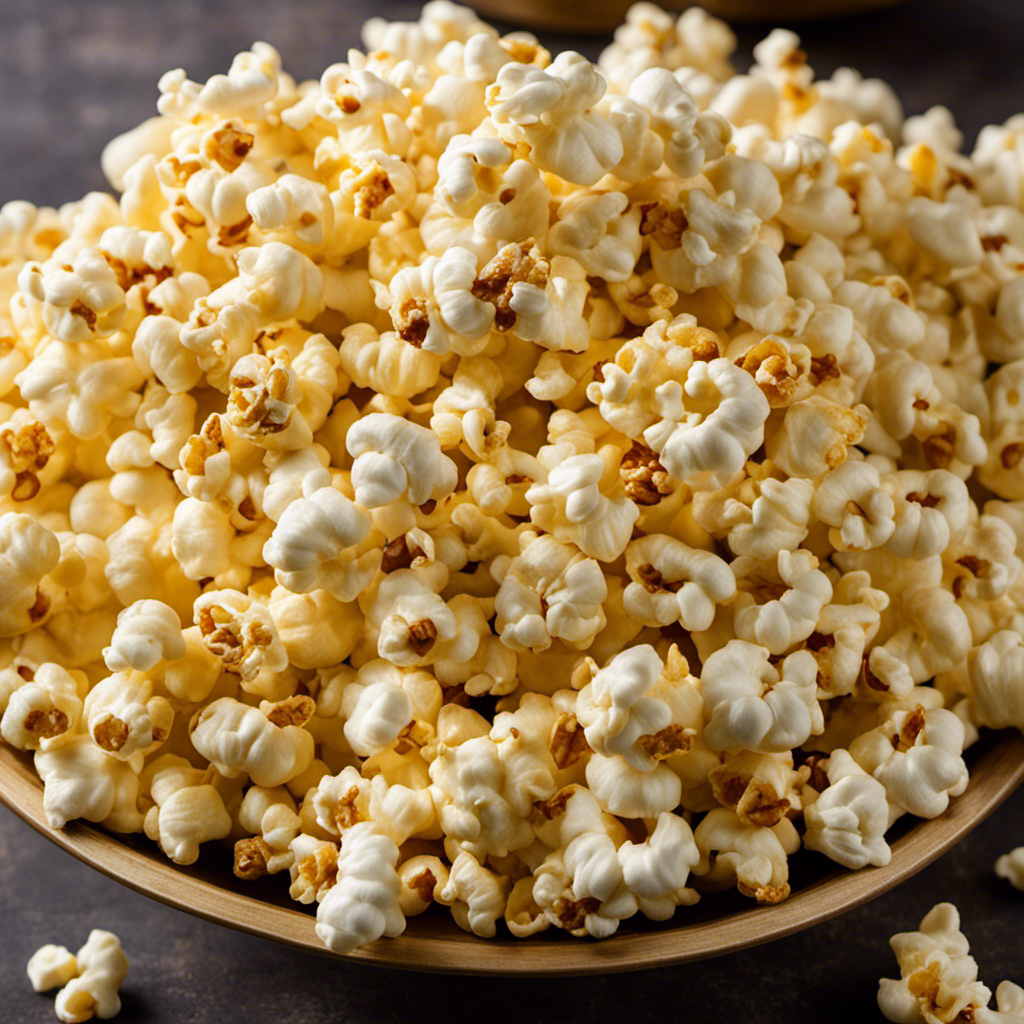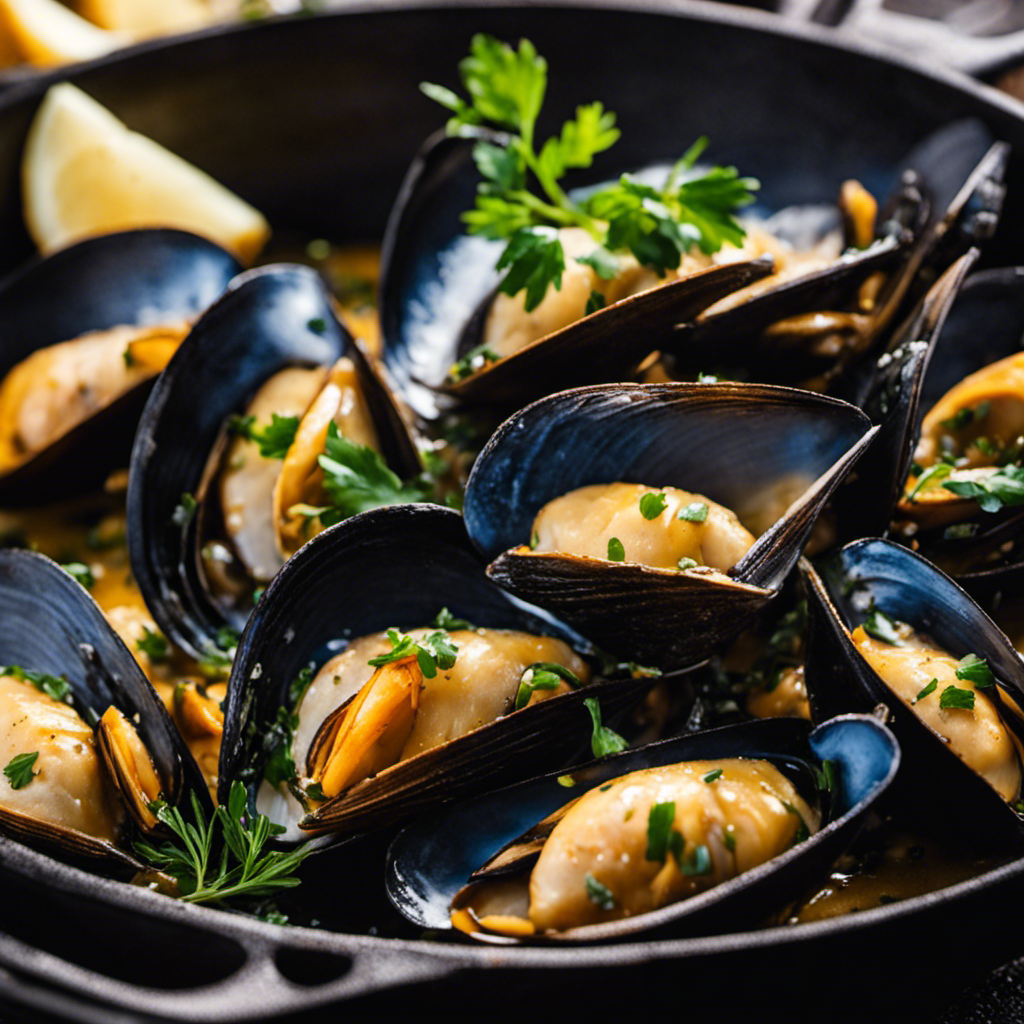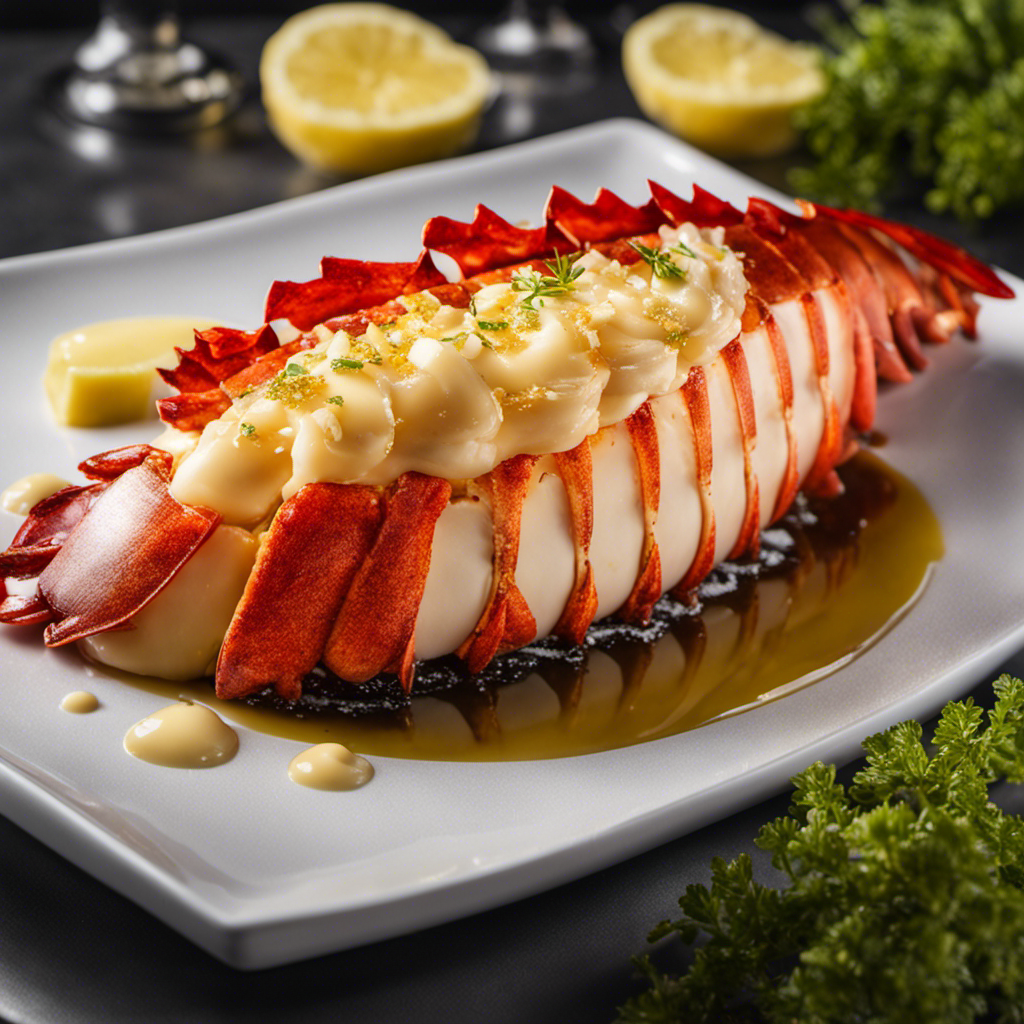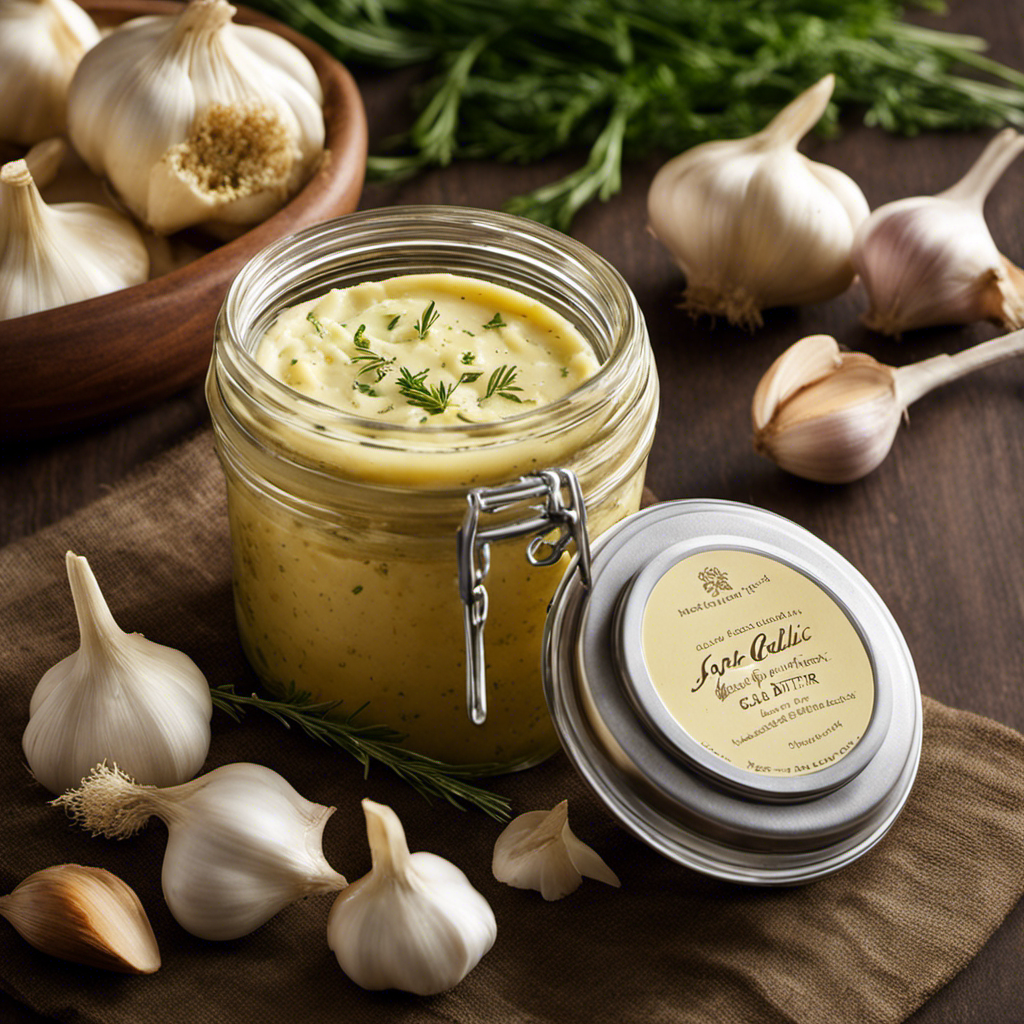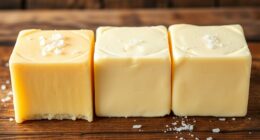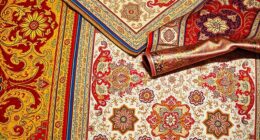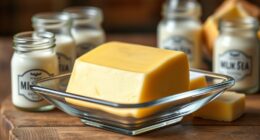I adore spending evenings watching films at home, yet nothing compares to the enticing scent of newly popped popcorn wafting through the room. Moreover, when it’s about savoring popcorn, the unbeatable taste is the luxurious, buttery flavor that envelops every piece.
In this article, I’ll show you how to butter popcorn from a popcorn maker, step-by-step. From choosing the right popcorn maker to serving and enjoying the buttered popcorn, I’ll guide you through the process to ensure you have the perfect movie snack every time.
Let’s get started!
Key Takeaways
- Master the art of melting butter for a perfect drizzle on popcorn.
- Use caution when melting butter to avoid burning.
- Pour melted butter over freshly popped popcorn in the popcorn maker.
- Use a spatula or spoon to gently toss the popcorn for even distribution.
Choosing the Right Popcorn Maker
If you’re looking for a popcorn maker, you’ll want to consider factors like size, wattage, and ease of use. Choosing the right popcorn maker can greatly enhance your popcorn-making experience.
One important aspect to consider is the size of the popcorn maker. If you have limited countertop space, you’ll want to opt for a compact size that can easily fit in your kitchen.
Wattage is another crucial factor to consider. Higher wattage means faster popping times, so if you’re someone who likes to enjoy popcorn quickly, a higher wattage popcorn maker would be ideal.
Ease of use is also important. Look for a popcorn maker with simple controls and clear instructions for hassle-free popping.
When it comes to choosing popcorn kernels, there are a few options available. The most common type is yellow popcorn, which produces big and fluffy kernels. If you prefer a more tender and delicate texture, white popcorn is a great choice. There are also gourmet popcorn kernels available in various flavors like caramel, cheese, and butter. These can add a fun twist to your popcorn-making experience.
While popcorn makers are generally reliable, there are some common issues you may encounter. One common problem is unpopped kernels. This can be caused by using low-quality kernels or not allowing enough time for the popcorn to pop fully.
Another issue you may face is burnt popcorn. To avoid this, make sure to monitor the popcorn closely and remove it from the heat source as soon as it’s done popping. Additionally, if your popcorn maker has a stirring mechanism, ensure that it is functioning properly to evenly distribute the heat and prevent burning.
Gathering the Necessary Ingredients
When it comes to making delicious popcorn, there are a few key techniques to keep in mind.
First, mastering the art of melting butter is crucial for achieving that perfect drizzle. Additionally, for those looking for alternative options, there are a variety of ingredients that can be used in place of butter.
Butter Melting Techniques
To evenly distribute melted butter on popcorn from a popcorn maker, you can try gently shaking the machine or using a spoon to drizzle the butter over the popcorn. This ensures that every piece gets a delicious buttery coating.
When it comes to melting butter for popcorn, there are a few techniques you can use. One option is to melt the butter in a microwave-safe bowl in short intervals, stirring in between until it becomes a smooth liquid. Another technique is to melt the butter in a saucepan over low heat, constantly stirring until it melts completely.
Once you have your melted butter, it’s time to add some flavor to your popcorn. Some popular suggestions include sprinkling salt, grated Parmesan cheese, or even a dash of chili powder for some extra kick.
Now, let’s explore some ingredient alternatives for butter that can still give your popcorn a delicious taste.
Ingredient Alternatives for Butter
One option for a delicious alternative to butter on popcorn is using olive oil. Not only does olive oil add a rich and savory flavor to your popcorn, but it is also a healthier option compared to butter. Olive oil is packed with monounsaturated fats, which are beneficial for heart health. It is also a great source of antioxidants and can help reduce inflammation in the body. To use olive oil on your popcorn, simply drizzle it over the hot popcorn and toss to evenly coat. You can also experiment with different flavors by adding herbs, spices, or even nutritional yeast for a cheesy taste. Here is a table showcasing some other ingredient alternatives for butter on popcorn:
| Alternative | Description | Health Benefits |
|---|---|---|
| Coconut Oil | Adds a subtle tropical flavor to your popcorn and is high in healthy fats. | Boosts metabolism |
| Ghee | Clarified butter that adds a rich and nutty flavor to your popcorn. | Lactose-free and high in vitamins |
| Avocado Oil | Provides a creamy and buttery taste to your popcorn and is rich in monounsaturated fats. | Supports skin and eye health |
| Nutritional Yeast | Gives a cheesy and savory flavor to your popcorn and is a good source of B-vitamins and protein. | Boosts immune system function |
With these ingredient alternatives, you can enjoy a healthier and equally delicious popcorn experience.
Enhancing Flavor With Seasonings
Adding seasonings is a simple way to enhance the flavor of your popcorn without using butter. There are endless possibilities when it comes to experimenting with flavors and enhancing taste.
For a savory option, try sprinkling some grated Parmesan cheese and garlic powder on top of your popcorn. The combination of the nutty cheese and the aromatic garlic will give your popcorn a delicious and irresistible taste.
If you prefer a spicier kick, mix some cayenne pepper, paprika, and a pinch of salt together and toss it with your popcorn. The heat from the cayenne pepper combined with the smoky flavor of paprika will create a unique and bold taste experience.
Don’t be afraid to get creative and try different seasonings to find your favorite flavor combination. Your taste buds will thank you!
Preparing the Popcorn Maker
When it comes to using a popcorn maker, two important factors to consider are temperature control and cleaning.
Proper temperature control ensures that your popcorn is cooked to perfection, with just the right amount of crunch and flavor.
Cleaning the popcorn maker is essential for maintaining its performance and prolonging its lifespan.
In this discussion, I will guide you through the ins and outs of temperature control and provide tips for keeping your popcorn maker in tip-top shape.
Popcorn Maker Temperature Control
To control the temperature of your popcorn maker, you’ll want to adjust the settings to your desired level. This will ensure that your popcorn pops perfectly every time. Here are some tips for maintaining your popcorn maker and troubleshooting any issues that may arise:
| Popcorn Maker Maintenance | Troubleshooting Popcorn Maker Issues |
|---|---|
| Clean the popcorn maker regularly to prevent buildup and ensure proper functioning. | If your popcorn maker is not heating evenly, check for any obstructions or loose wires. |
| Lubricate moving parts with food-grade oil to keep them running smoothly. | If the popcorn maker is not popping the kernels, make sure the heating element is working properly. |
| Check the power cord for any damage and replace if necessary. | If the popcorn comes out burnt, reduce the temperature setting and monitor closely. |
| Use the recommended amount of oil and popcorn kernels for optimal results. | If the popcorn maker is making loud noises, there may be an issue with the fan or motor. |
| Store the popcorn maker in a cool, dry place when not in use. | If you encounter any other issues, refer to the manufacturer’s manual or contact customer support. |
Cleaning the Popcorn Maker
Cleaning your popcorn maker is an essential step in maintaining its performance and longevity. Proper cleaning techniques and maintenance tips can ensure that your popcorn maker continues to produce delicious popcorn for years to come.
To start, always unplug the machine and allow it to cool down completely before cleaning. Use a damp cloth or sponge to wipe away any oil or butter residue on the exterior. For the interior, remove any leftover popcorn kernels and wipe away any excess oil.
If your popcorn maker has a removable tray or bowl, wash it with warm soapy water and dry thoroughly before reassembling. Regular cleaning not only keeps your popcorn maker in top shape but also ensures that your popcorn tastes fresh every time.
Now that your popcorn maker is clean, let’s move on to measuring the popcorn kernels.
Measuring the Popcorn Kernels
Before starting, make sure you’ve measured the correct amount of popcorn kernels. It’s important to have the right amount of kernels to ensure a perfect batch of popcorn. The size of the popcorn kernels can vary, so it’s essential to measure them accurately. While a measuring cup is commonly used for this purpose, there are also some alternative methods you can try.
One alternative to a measuring cup is using a kitchen scale. This is a more precise method as it allows you to measure the exact weight of the kernels. Simply place a bowl on the scale, reset it to zero, and then add the desired amount of kernels until you reach the desired weight.
Another option is using a tablespoon. A tablespoon can hold approximately 16 kernels, so you can easily estimate the amount you need by counting the tablespoons. Keep in mind that this method might not be as accurate as using a measuring cup or a kitchen scale, but it can still give you a good estimate.
Regardless of the method you choose, it’s important to ensure that you have the correct amount of popcorn kernels before starting your popcorn maker. This will help you achieve the perfect batch of popcorn every time.
Adding Oil to the Popcorn Maker
When it comes to adding oil to the popcorn maker, there are a few key points to consider.
First, the type and amount of oil used can greatly impact the taste and texture of the popcorn.
Secondly, it is important to ensure an even distribution of oil throughout the popcorn kernels for a consistent and flavorful snack.
Lastly, the oil used can have a significant effect on the overall taste of the popcorn, so it’s worth experimenting with different oils to find your preferred flavor profile.
Oil Type and Amount
To achieve the perfect buttery flavor, it’s important to use the right type and amount of oil in your popcorn maker. The oil quality plays a significant role in enhancing the taste of your popcorn. Opt for high-quality oils like coconut oil, avocado oil, or grapeseed oil, as they have a neutral flavor and a high smoke point. These oils will prevent the popcorn from tasting greasy and will allow the butter flavor to shine through. If you prefer a healthier option, you can also try butter alternatives like ghee or olive oil. It’s essential to use the right amount of oil as well, as too much can make the popcorn soggy. A general rule of thumb is to use 1-2 tablespoons of oil per 1/4 cup of popcorn kernels. By using the right oil and amount, you’ll achieve popcorn perfection.
| Oil Type | Flavor Profile | Smoke Point |
|---|---|---|
| Coconut oil | Neutral | 350°F |
| Avocado oil | Neutral | 520°F |
| Grapeseed oil | Neutral | 420°F |
As mentioned earlier, the quality and type of oil used in your popcorn maker can greatly impact the taste. By choosing high-quality oils with neutral flavors and high smoke points, you can ensure that your popcorn doesn’t taste greasy and allows the butter flavor to shine through. However, if you’re looking for a healthier alternative, you can also try using ghee or olive oil. These butter alternatives can provide a unique taste to your popcorn while still maintaining a delicious flavor. Experimenting with different oils can be a fun way to customize your popcorn experience. Now that we know the importance of selecting the right oil, let’s move on to the next section and learn about the importance of even distribution.
Importance of Even Distribution
Achieving even distribution of oil throughout the popcorn kernels is crucial for ensuring consistent flavor and preventing any greasy or soggy patches. To achieve the perfect popcorn coating, here are three key steps:
-
Use a popcorn maker with a built-in butter dispenser: This ensures that the melted butter is evenly distributed over the popcorn as it pops, resulting in a delicious and uniform coating.
-
Toss the popcorn: After the popcorn is done popping, give it a gentle toss in the popcorn maker to ensure that the butter is evenly distributed. This step helps to coat every kernel with a thin layer of butter, enhancing the flavor.
-
Add additional melted butter: If you prefer a heavier butter coating, drizzle some melted butter over the popcorn and toss it again. This step allows you to customize the amount of butter to your liking while still achieving even distribution.
Effect on Popcorn Taste
For a tastier popcorn experience, ensure that the flavor is evenly distributed throughout each kernel. This is crucial because it allows you to fully enjoy the deliciousness of every bite. When the flavor is evenly distributed, each kernel becomes a burst of taste in your mouth. To enhance your popcorn even further, try experimenting with alternative toppings. You can add a sprinkle of Parmesan cheese for a savory twist or drizzle some melted chocolate for a sweet indulgence. These alternative toppings not only add variety to your popcorn but also provide additional health benefits. For example, Parmesan cheese is a good source of protein and calcium, while dark chocolate contains antioxidants that can boost your mood. So go ahead and get creative with your popcorn toppings, and enjoy a tastier, healthier snack!
| Toppings | Health Benefits |
|---|---|
| Parmesan Cheese | Protein and Calcium |
| Dark Chocolate | Antioxidants and Mood Boost |
| Caramel Sauce | Energy and Iron |
Turning on the Popcorn Maker
Once you’ve turned on the popcorn maker, you can begin preparing the butter for your popcorn. But before we get into that, let’s talk about some important popcorn maker safety precautions to keep in mind. Safety should always be the top priority when using any kitchen appliance. Here are a few key safety tips to follow:
-
Always read the instruction manual thoroughly before using the popcorn maker. Familiarize yourself with the machine’s features and functions to ensure proper and safe operation.
-
Make sure the popcorn maker is placed on a stable and heat-resistant surface. This will prevent any accidents or damage caused by the machine tipping over.
-
Never leave the popcorn maker unattended while it’s in use. It’s important to keep an eye on the popcorn as it pops to prevent any potential fire hazards.
Now, let’s move on to troubleshooting common popcorn maker issues. Here are three common problems you may encounter and their solutions:
-
Popcorn not popping evenly: This could be due to a clogged vent or improper heat distribution. Clean the vent and ensure the popcorn maker is placed on a level surface to solve this issue.
-
Burnt popcorn: Adjust the heat settings or try using a lower heat setting to prevent the popcorn from burning.
-
Machine not turning on: Check if the power cord is securely plugged in and the outlet is functioning. If the problem persists, contact the manufacturer for further assistance.
Allowing the Popcorn to Pop
When it comes to making the perfect bowl of popcorn, there are a few key points to consider.
First, mastering the popcorn popping techniques is crucial. Whether it’s shaking the pot on the stovetop or using a popcorn maker, finding the right method can make all the difference.
Second, understanding the ideal popping temperature is essential. Too low and you’ll end up with a bag of unpopped kernels; too high and you risk burning the popcorn.
Lastly, timing is everything when it comes to popping corn. Knowing when to take the pot off the heat or when to stop the popcorn maker can ensure that you have a perfectly popped batch every time.
Popcorn Popping Techniques
To achieve the perfect popcorn popping results, it’s important to use the right amount of oil and heat. Here are some techniques that can help you achieve the best popcorn popping experience:
-
Choose the right popcorn kernel types: There are different varieties of popcorn kernels available, such as butterfly and mushroom kernels. Butterfly kernels are more common and produce fluffy popcorn, while mushroom kernels are smaller and denser.
-
Listen for popping sound indicators: As the popcorn kernels heat up, they start to pop. The popping sound is an important indicator of when the popcorn is ready. Initially, you will hear a few pops, but as the temperature increases, the pops will become more frequent.
-
Pay attention to the popping rhythm: The popcorn should pop consistently and evenly. If you notice any gaps or a slow popping rhythm, it could be a sign that the heat is not distributed evenly or that you need to adjust the cooking time.
Ideal Popping Temperature
After learning about different popcorn popping techniques, let’s dive into the ideal popping time and the benefits of using a popcorn maker.
The ideal popping time for popcorn is around 2-3 minutes, depending on the type of popcorn and the heat level. Using a popcorn maker ensures that the kernels heat evenly and pop to perfection.
One of the benefits of using a popcorn maker is that it eliminates the guesswork. With precise temperature controls, you can achieve consistent results every time. Additionally, using a popcorn maker means less oil is needed compared to stovetop popping methods, making it a healthier option.
Now that we know the benefits of using a popcorn maker, let’s move on to the next section, where we will explore the timing for popping corn.
Timing for Popping Corn
Using a popcorn maker ensures consistent and precise timing for popping corn. Here are three key factors to consider when timing the popping of corn kernels:
-
Preheat Time: Before adding the corn kernels, allow the popcorn maker to preheat for a few minutes. This ensures that the popping process begins as soon as the kernels are added, resulting in evenly popped popcorn.
-
Kernel Quantity: Overloading the popcorn maker with too many kernels can lead to uneven popping and lower quality popcorn. It’s important to follow the manufacturer’s guidelines for the maximum quantity of kernels to use.
-
Popping Time: The popping time can vary depending on the popcorn maker and the specific brand of corn kernels being used. It’s crucial to monitor the popping process closely and remove the popcorn from the maker once the popping slows down to prevent burning.
Melting the Butter
First, you’ll need to melt the butter for your popcorn in a small saucepan. However, if you’re looking for alternatives to melting butter, you can try using flavored oils to add a unique twist to your popcorn. Flavored oils are readily available in grocery stores and can be a healthier option compared to butter. They come in various flavors such as garlic, truffle, and chili, allowing you to experiment and find your favorite combination.
To melt the butter, simply follow these steps:
- Place the butter in the small saucepan.
- Heat the saucepan over low to medium heat.
- Stir the butter occasionally until it completely melts.
- Once melted, remove the saucepan from the heat and set it aside.
Now, if you decide to use flavored oils instead, the process is just as simple. Use the table below to choose your desired oil and follow the same steps as melting butter:
| Flavor | Oil |
|---|---|
| Garlic | Olive oil |
| Truffle | Truffle oil |
| Chili | Chili oil |
| Butter | Butter-flavored oil |
Remember to drizzle the oil over your popcorn and toss it well to evenly distribute the flavor. Enjoy your buttery (or flavored) popcorn!
Adding Butter to the Popcorn Maker
When adding butter to the popcorn maker, make sure to use caution and not overload the machine. Adding butter to freshly popped popcorn can enhance its flavor and make it even more delicious. Here are some tips on adding butter to your popcorn maker:
-
Butter Measurement: To achieve the perfect buttery taste, it’s important to measure the right amount of butter. I usually go for around 2 to 3 tablespoons of melted butter per 4 cups of popcorn. Adjust the amount according to your taste preferences.
-
Butter Melting Techniques: There are a few ways to melt the butter before adding it to the popcorn maker. One easy method is to microwave the butter in a microwave-safe bowl for about 30 seconds. Another option is to melt the butter on the stovetop over low heat. Whichever method you choose, make sure the butter is completely melted and smooth.
-
Adding the Butter: Once the butter is melted, carefully pour it over the freshly popped popcorn in the popcorn maker. Use a spatula or a spoon to gently toss the popcorn, ensuring that each kernel gets coated with the delicious buttery goodness. Take your time and make sure the butter is evenly distributed.
Adding butter to your popcorn maker can take your popcorn to the next level of yumminess. Just remember to use caution, measure the right amount of butter, and distribute it evenly.
Enjoy your buttery popcorn!
Mixing the Butter and Popcorn
To evenly distribute the melted butter, gently toss the popcorn in the popcorn maker with a spatula or spoon. This step is crucial in ensuring that each kernel gets coated with the delicious buttery goodness.
Now, let’s talk about the different butter melting methods and butter distribution techniques that you can use to enhance your popcorn experience.
When it comes to melting butter, there are a few popular methods you can try. One option is to melt the butter in a microwave-safe bowl. Simply place the desired amount of butter in the bowl and microwave it in short intervals, stirring in between, until it is completely melted.
Another method is to melt the butter on the stovetop. Just place the butter in a small saucepan over low heat and stir occasionally until it has melted.
Once your butter is melted, it’s time to distribute it onto the popcorn. You can do this by pouring the melted butter evenly over the popcorn in the popcorn maker and then tossing it with the spatula or spoon. Make sure to gently mix the popcorn to ensure that every kernel gets a taste of that rich, buttery flavor.
Alternatively, if your popcorn maker has a built-in butter dispenser, you can simply add the melted butter to the dispenser and let it distribute onto the popcorn as it pops.
Seasoning Options for Flavored Popcorn
One option for adding flavor to your popcorn is by using different seasonings. It’s a fun and creative way to elevate the taste of your popcorn and make it more exciting. Here are three delicious flavored popcorn seasonings that you can try:
-
Classic Salt and Butter: This timeless combination is a crowd favorite. Simply melt some butter and drizzle it over your freshly popped popcorn. Then, sprinkle some salt evenly to enhance the flavor. The rich and savory taste of butter combined with the slight saltiness creates a mouthwatering treat.
-
Sweet and Spicy: For those who enjoy a little heat with their snacks, this combination is perfect. Mix together some chili powder, brown sugar, and a pinch of cayenne pepper. Sprinkle this mixture over your popcorn and toss it well to coat evenly. The sweetness from the sugar balances out the spiciness, creating a unique and addictive flavor.
-
Cheesy Ranch: If you’re a fan of cheesy and tangy flavors, this seasoning is a must-try. Mix together grated Parmesan cheese, dried dill, garlic powder, and onion powder. Sprinkle this mixture over your popcorn and toss it gently to coat. The combination of the creamy cheese and tangy ranch flavors will have you reaching for more.
These creative popcorn toppings are just the beginning. Feel free to experiment with different seasonings and create your own unique flavor combinations. Happy snacking!
Adding Salt to the Popcorn
Using salt is a simple way to enhance the flavor of your popcorn. It adds a savory element that perfectly complements the buttery goodness. However, it’s important to find the right balance and measurement when adding salt to your popcorn. Too little and it may taste bland, but too much can make it overpowering.
To ensure the perfect amount of saltiness, it’s helpful to have a guide on how much salt to use. Here’s a handy table to give you an idea of the salt measurement based on the amount of popcorn you’re making:
| Amount of Popcorn | Salt Measurement |
|---|---|
| Small bowl (1-2 cups) | 1/4 teaspoon |
| Medium bowl (3-4 cups) | 1/2 teaspoon |
| Large bowl (5-6 cups) | 3/4 teaspoon |
| Extra-large bowl (7+ cups) | 1 teaspoon |
Remember, these measurements are just a starting point. Feel free to adjust according to your taste preferences.
When it comes to choosing the type of salt for your popcorn, there are a few options. The most common type is fine table salt, which dissolves easily and evenly coats the popcorn. However, if you prefer a bit of texture, you can use kosher salt, which has larger grains. Sea salt can also add a subtle briny flavor to your popcorn.
Tossing the Popcorn to Distribute the Butter
As you shake the bowl, the butter-coated popcorn will distribute evenly. Tossing the popcorn is a crucial step in ensuring that every kernel gets a fair share of that delicious buttery goodness. Here’s how to do it:
-
Get a large bowl: Choose a bowl that is big enough to hold all the popcorn without making a mess. The larger the bowl, the easier it will be to toss the popcorn.
-
Lift and shake: Hold the bowl with both hands and lift it slightly off the table. Give the bowl a gentle shake back and forth, making sure to keep the popcorn moving. This motion will help distribute the butter evenly.
-
Use a tossing motion: Instead of just shaking the bowl, try tossing the popcorn up into the air and catching it back in the bowl. This action helps mix the popcorn and ensures that every kernel gets coated with butter.
Serving and Enjoying the Buttered Popcorn
After tossing the popcorn to distribute the butter and ensuring each fluffy kernel is coated in its golden goodness, it’s time to serve and enjoy the mouthwatering creation.
Serving buttered popcorn is an art in itself, and there are a few techniques and toppings you can use to take your snacking experience to the next level.
One popular serving technique is to pour the buttered popcorn into a large bowl or individual serving bowls. This not only makes it easier to share with friends and family but also adds a touch of elegance to your movie night or gathering. Alternatively, you can serve the popcorn in fun and creative containers like popcorn cones or paper bags for a more casual vibe.
To enhance the flavor of your buttered popcorn, you can experiment with various toppings. Classic options include grated Parmesan cheese, a sprinkle of sea salt, or a dash of black pepper. For a sweet and savory twist, you can try drizzling your popcorn with melted chocolate or caramel sauce. Other popular choices include chili powder, garlic powder, or even nutritional yeast for a cheesy, dairy-free option.
No matter how you choose to serve and top your buttered popcorn, remember to enjoy it while it’s still warm and freshly made. The combination of the buttery goodness and the satisfying crunch of the popcorn is sure to make your taste buds dance with delight.
Cleaning and Maintaining the Popcorn Maker
To keep your popcorn maker in top shape, it’s important to regularly clean and maintain it. Here are some cleaning techniques and troubleshooting tips to help you keep your popcorn maker in perfect working order:
-
Clean the exterior: Wipe down the outside of the popcorn maker with a damp cloth and mild soap. Avoid using abrasive cleaners that could damage the finish.
-
Remove and clean the popping chamber: Before cleaning the popping chamber, make sure the machine is unplugged and has cooled down. Remove any leftover popcorn kernels and wipe the chamber with a damp cloth. For stubborn residue, use a mild dish soap and warm water.
-
Clean the chute and butter tray: Remove the chute and butter tray, if applicable, and soak them in warm, soapy water. Scrub gently to remove any butter or oil buildup. Rinse thoroughly and dry before reattaching.
Troubleshooting common issues:
-
If your popcorn maker is not popping the kernels evenly, try adjusting the heat or stirring the kernels periodically while they pop.
-
If the machine is not turning on, check the power cord and ensure it is securely plugged in. If the problem persists, contact the manufacturer for further assistance.
-
If the popcorn is coming out burnt or too dry, reduce the cooking time or adjust the heat settings to avoid overcooking.
Regular cleaning and maintenance will not only ensure your popcorn maker lasts longer, but also help you enjoy delicious, buttery popcorn every time.
Frequently Asked Questions
How Do I Clean and Maintain My Popcorn Maker?
Cleaning and maintaining my popcorn maker is important for its longevity and performance. I follow a regular maintenance schedule, which includes wiping it down after each use and deep cleaning it every few months.
Can I Use a Different Type of Oil Besides the One Recommended in the Recipe?
I can use a different type of oil to butter popcorn from a popcorn maker. However, it’s important to consider the pros and cons of different oils for this purpose.
What Are Some Alternative Seasoning Options for Flavored Popcorn?
When it comes to flavored popcorn, there are endless options to get creative. From different types of cheese to sprinkle on top, to sweet and savory seasoning combinations, the possibilities are deliciously exciting.
How Long Should I Allow the Popcorn to Pop in the Popcorn Maker?
To achieve perfectly popped popcorn in a popcorn maker, it’s important to allow the kernels to pop for the right amount of time. Here are some tips for seasoning popcorn in creative ways.
Can I Use Margarine Instead of Butter to Butter the Popcorn?
Using margarine as an alternative to butter when buttering popcorn from a popcorn maker is possible. However, keep in mind that margarine has a different taste and texture compared to butter.
Conclusion
In conclusion, buttering popcorn from a popcorn maker is a simple and satisfying process. By choosing the right popcorn maker and gathering the necessary ingredients, you can create a delectable snack that will leave your taste buds tingling.
Measuring the popcorn kernels, adding oil and salt, and tossing the popcorn to distribute the butter ensures a perfectly buttered batch every time. So, sit back, relax, and indulge in the mouthwatering magic of buttered popcorn.
Let the buttery bliss transport you to a world of pure pleasure!
